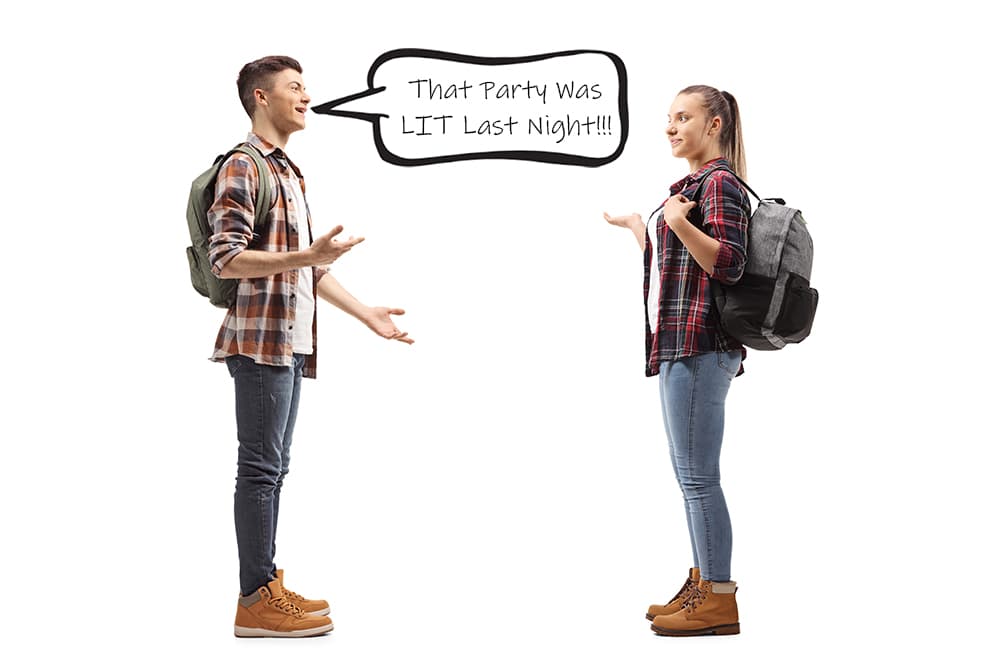 “The tipping point is that magic moment when an idea, trend, or social behavior crosses a threshold, tips, and spreads like wildfire”--Malcolm Gladwell, in his book The Tipping Point: How Little Things Can Make a Big Difference.
Malcolm Gladwell’s book The Tipping Point is one of the key texts in studies on society and culture. In this book, Gladwell talks about how major trends in the past and present are fuelled by smaller movements in society. For example, he talks about how different shoes became popular due to a minority of young people wearing them as a fashion statement.
Keeping this sociological principle in mind, this article will help you understand teen talk and the use of slang in 2020 and beyond. It will provide the context for these linguistic terms as well as why these terms matter in the first place. As you’ll discover, teen talk can give you insight into teens and consumer culture.
“The tipping point is that magic moment when an idea, trend, or social behavior crosses a threshold, tips, and spreads like wildfire”--Malcolm Gladwell, in his book The Tipping Point: How Little Things Can Make a Big Difference.
Malcolm Gladwell’s book The Tipping Point is one of the key texts in studies on society and culture. In this book, Gladwell talks about how major trends in the past and present are fuelled by smaller movements in society. For example, he talks about how different shoes became popular due to a minority of young people wearing them as a fashion statement.
Keeping this sociological principle in mind, this article will help you understand teen talk and the use of slang in 2020 and beyond. It will provide the context for these linguistic terms as well as why these terms matter in the first place. As you’ll discover, teen talk can give you insight into teens and consumer culture.
The Sociolinguistics of Teen Talk
As Gladwell and other sociologists have found, young people are some of the key demographics in starting and maintaining trends. That is why many strategists and economists turn to teens in order to understand future trends and movements. So besides being part of the “in crowd,” learning how teens talk can help you in many ways. Here’s why you need to learn slang used amongst teens:Psychology: Teens’ Brains Are Very Elastic.
- a. While adults may seem to be stuck in the past and rigid, teens brains are very elastic. That means that while you’re still holding on to the old and traditional way of doing things, teens are leading society and culture by shaping what’s said and done. Learning teen talk, then, allows you to have a mindset based on growth and change rather than insisting that other people meet you based on your own terms.
Society: Teens' Use Of Language Shapes The Present And Future.
- a. This idea is important because of what linguists refer to as descriptive and prescriptive uses of language. Prescriptive uses of language is language that you learn through education, dictionaries, and other formal sources. Descriptive language, however, is language shaped by society and culture. Your teen (and even you when you were a teen!) is one of the key determiners of descriptive uses of language.
Economics: Teens’ use of language gives you insight into consumer culture.
- a. While you might smile at your teens’ use of slang, if you’re willing to listen to and learn then you’ll also learn about how consumer culture operates.
Slay The Conversations You Have with Your Teen: 10 Terms You Need to Know
Now that you’ve gained insight into why teen talk matters on many scales, learn 10 terms that will help you slay your conversations with your teen.1. Slay
- a. If you’ve heard Beyonce’s song, “Formation”, you’ve heard her singing “I slay.” The term “slay” is used to describe when something has been pulled off or done well. Example: “Did you see him? He slays.”
2. Extra
- a. This term means being over the top or exaggerating. Example: “That’s so extra.”
3. Flex
- a. This term means to put on display or show off. Example: “She's been flexing on him lately.”
4. Thirsty
- a. To be needy or desperate. Example: “All these thirsty guys are running around out here.”
5. Bet
- a. Often popular amongst teen boys, the term “bet” is used to accept or acknowledge a challenge. It’s also used just as a way of saying “yes.” Example: “Are you gonna get your homework done today?” “Bet!”
6. Lit
- a. Sometimes used with or in place of this emoji 🔥, lit means something exciting, provoking, or “cool.” In talking about drugs, lit can also mean getting “high” or getting intoxicated. Example: That party was pretty lit last night.
7. Highkey/Lowkey
- a. Highkey describes anything blunt, direct, or in your face. Lowkey, on the other hand, is subtle. Example: “She lowkey shut that down!”
8. Shook
- a. This term means to be surprised or thrown off. Example: “I’m shook!”
9. Shade
- a. This term means to subtly do something. Often to subtly criticize something or someone. Example: “No shade, but that hair color doesn’t look good.”
10. Stan
- a. This term means to be a big fan or supporter of something. The term comes from one of the songs by the rapper Eminem. Example: “Justin Beiber just came out with a new song. I stan!"


Leave a Reply